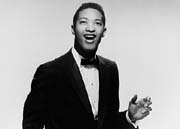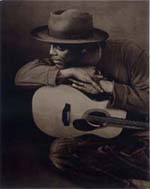Bring It On Home To Me
 |
Sam Cooke (shown right) is universally regarded as one of the first and finest representatives of what eventually came to be known as soul music. He was born in 1931 and, like so many of his generation started out singing gospel music, first in church and later as lead vocalist for the Soul Stirrers, one of the top acts on the all-gospel circuit in the 40's and 50's. Passionate and polished, the group provided a superb training ground for the young singer and he, in turn, helped them achieve new heights of popularity with vocals of the sort you hear on this clip from 1953.
Audio Clip: The Soul Stirrers, I'd Give up All My Sins and Serve the Lord
At that time (as today, to a lesser degree) there were many in the black community who considered it scandalous that a gospel singer would also perform jazz, blues or any other form of secular music. Ray Charles was on the front lines of that battle when the recording you just heard was made and it would not be long before Cooke was down in the trenches as well. He first tried making the switch by recording under cover of an alias (Dale Cooke) in 1956. His vocals were too well known and too distinctive for that ruse, however, and he soon had to choose between the two paths. In 1957 his hit single, You Send Me, cleared the way for a hugely successful, if brief, career as a soulful pop crooner. He was a regular on the pop and R&B charts from then until well after his death in 1964 in a shooting incident that is shrouded in both mystery and controversy to this day.
Bring It On Home To Me was released in 1962 and is among The Rock and Roll Hall of Fame's 500 Songs that Shaped Rock and Roll. An interesting tidbit of R&B trivia: the recording features Lou Rawls as a backup singer. You hear him in the following clip contributing not only harmony, but the familiar call and response with Cooke at the end of each verse.
Audio Clip: Sam Cooke sings Bring It On Home To Me
 |
The song has been covered by a large number and wide variety of artists from rockers (The Animals, Bon Jovi, Dave Mason) to bluegrass and country artists (The Dixie Chicks included it on their debut) and of course countless blues and R&B singers. Here's a 2006 recording from guitarist, singer and songwriter Tab Benoit, a blues musician who hails from the New Orleans area. Notice that his version uses a different bass line than ours, but because both arrangements share a clear 6/8 feel (two strong beats per measure, each of which is divided into three) you could swap one for the other. Try it!
Audio Clip: Tab Benoit on Bring It On Home To Me
Although we're playing the song using the simplest of I-IV-V chord progressions (as in the Cooke clip above), it does allow for considerable embellishment. The next audio clip is from a pianist/singer/songwriter from England named Paul Millns. His piano arrangement adds some nice passing chords and a turnaround that would have been very familiar to the congregation of the Chicago church where Cooke's father preached—and equally familiar to the patrons of the city's blues clubs. Although we may not be able to get these exact chord voicings on guitar, we can capture the essentials and it would be a fun challenge to work up a guitar-friendly version of Millns' arrangement. Have a listen and give it a try if you'd like:
Audio Clip: Paul Millns on Bring It On Home To Me
 |
Here's one last clip, from contemporary bluesman Eric Bibb. This take on the song has yet another, very distinctive feel. Bibb himself was raised in New York and now resides in Sweden, but the groove is pure Louisiana. (Or does every New Englander say that when there's an accordion in the mix?) In any case, stick around for the solo after Bibb and Co.'s spirited and infectious vocals. It ought to give reassurance to those who suffer under the impression that a solo has to be fancy or fast to be effective. It has to be neither. You just have to say what you mean—clearly and with conviction. Listen:
Audio Clip: Bring It On Home to Me from Eric Bibb's 2000, Home To Me
Recommended Recordings
All Community Guitar Resources text & material © 2006 Andrew Lawrence
